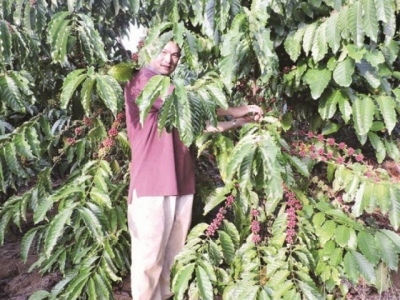Coffee export handshake to overcome difficulties

Despite being the world's second largest exporter, but over the years, Vietnamese coffee has almost no reputation in the international market. Focusing on branding and promoting international cooperation are seen as a viable solution to help this industry develop sustainably.
Currently, about 90% of Vietnamese coffee is still exported in raw form. Photo: Nguyen Thanh
Increase quantity, decrease cost
According to the latest statistics of Ministry of Agriculture & Rural Development (MARD), coffee exports in February were estimated at 146,000 tons, valued at 280 million dollars, bringing the volume of coffee exports in the first two months to 347 thousand tons and 672 million USD, up 21.5% in volume and 3.9% in value over the same period in 2017. However, in terms of price, the average price of coffee in the first month was only 1,952USD/ton, down 13.5 % over the same period of 2017. Germany and the United States continue to be the two largest coffee consuming markets of Vietnam in January with market share of 13.4% and 12.2%, respectively.
According to Mr. Nguyen Manh Dung from the Agro Processing and Market Development Authority (MARD), though ranked second in the world, from now until 2020 and vision toward 2030, Vietnam will reduce the coffee planting area, reduce the export of coffee beans, and increase production of processed coffee.
Mr. Do Kim Lang, Deputy Director General of Vietnam Trade Promotion Agency under the Ministry of Industry and Trade stated that Vietnam mainly produces and exports coffee beans, which do not bring high added value. The world knows that Vietnam exports coffee, but in fact they do not know how Vietnam’s coffee is. Some brands such as Trung Nguyen, Nguyen Trang ... have exported coffee to international markets by themselves, but most of the market is not competitive with the global level, even Vietnamese coffee does not enter the global value chain.
"Vietnamese coffee is mainly involved in the chain at the bottom level or at the starting point which has not much value. If there is investment cooperation, foreign companies also bring machinery into production and export products. However, it is not a pure Vietnamese coffee brand product. The Vietnam coffee industry must pay attention to all these things to change quickly", said Mr. Lang.
According to Lang, in the current context, the government is more interested in promoting the export of branded goods, increasing the value as well as competitiveness of export products in the market. Branding for the coffee industry or any other sectors is the main objective of Vietnam in exporting agricultural products. The Vietnam Trade Promotion Agency is presiding over the branding of products, especially foodstuffs. In particular, coffee is a priority industry. In 2018, the Ministry of Industry and Trade will develop a brand strategy for coffee in the branding strategy of food in general. This is a good solution for developing the coffee industry, helping to overcome the main problem of bean coffee export. However, this requires close coordination between the Ministry of Agriculture and Rural Development and the Ministry of Industry and Trade.
Cooperation for development
Regarding developing and increasing competitiveness of the coffee industry, some experts said that promoting cooperation in many aspects with the growing and exporting coffee countries in the world is also an important solution in the context of deep economic integration today.
At the workshop "Enhancing Indonesia-Vietnam Coffee Cooperation" recently, a representative of Indonesian Chamber of Commerce and Industry stated that apart from Brazil, Vietnam, Indonesia and Colombia are leading coffee exporting countries in the world. In order to improve the value of coffee, Vietnam and Indonesia can boost their cooperation. Vietnam is capable of supplying large quantities of coffee with relatively good production costs. The two sides can support and co-operate with each other through investing between the manufacturers of Vietnam and Indonesia. With that, the two sides can complement and cooperate in both production and marketing products in the world market. When it comes to sharing costs, at some point, production costs will be lower.
"For example, in the Robusta coffee growing process, both Indonesia and Vietnam may share costs associated with climate-induced risks. The Indonesian Coffee Research Institute will work out a strategy to cope with climate change to minimize the impact on the coffee industry. In addition, the two countries can also support each other during the coffee test to better meet the needs of consumers and international standards as well. The highest goal is to bring the two countries' coffee products into the world market at a competitive price", the representative said.
Related news
 Vietnam spends big on abattoir training to secure Aussie cow imports
Vietnam spends big on abattoir training to secure Aussie cow imports Cows are seen in an enclosure at a livestock export yard in Noonamah, about 50Km south of the northern Australian city of Darwin. Photo by Reuters/Tim Wimborne
 Vietnam encourages Japanese investment in manufacturing, hi-tech agriculture
Vietnam encourages Japanese investment in manufacturing, hi-tech agriculture Vietnam always encourages and creates all possible conditions for Japanese firms to invest in the country, especially in manufacturing industry, high-tech agri
 The Furniture Farmer
The Furniture Farmer Imagine a forest where trees turn themselves into chairs, lamps and mirror frames in a sustainable system that doesn’t leave a gaping hole